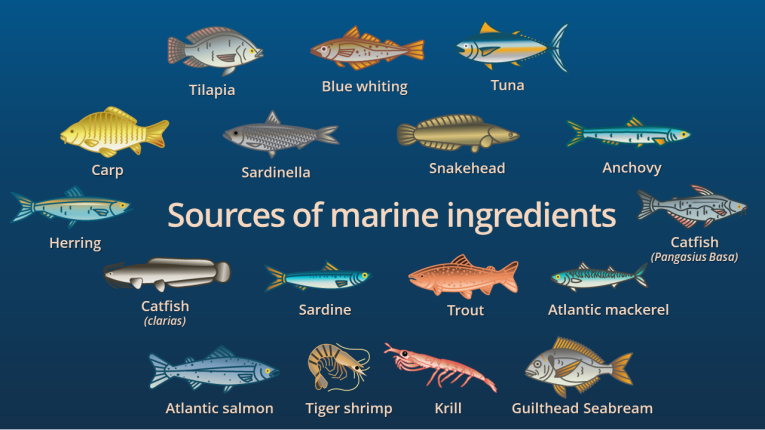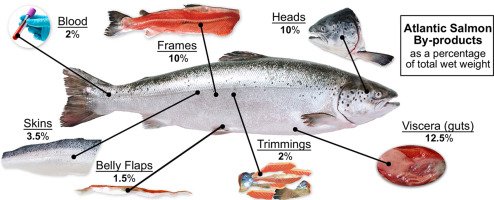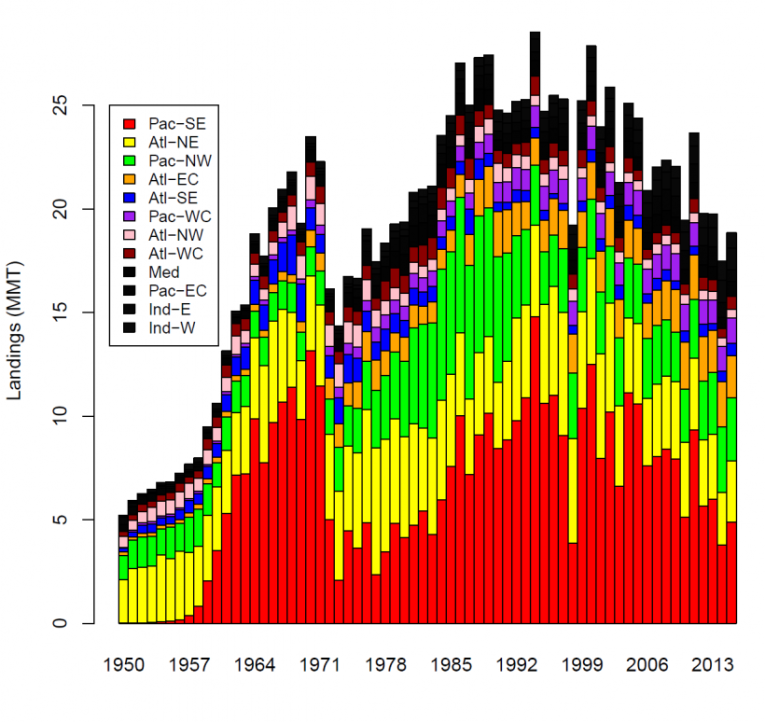In brief
- Derived from mostly from forage fish (small pelagics), marine organisms such as fish, krill, shellfish and algae
- A growing amount comes from by-products (fish trimmings): currently one third of the world’s fishmeal production and more than fifty percent of all fish oil.

Forage fish and whole fish: Utilising a natural resource for food production
Predominantly the species used for fishmeal and fish oil production are the small pelagic fish species, often known as “forage fish” due to their position in lower trophic levels in marine ecosystems. Many feed directly on phytoplankton or zooplankton species, and are important in providing prey (food availability) for the higher trophic levels in those ecosystems (Englehard, et al., 2013). Under the right environmental conditions stocks of forage fish populations can be highly productive, and some researchers emphasise the importance of the environment, rather than fishing pressure, in driving total stock biomass, assuming appropriate management is in place (Hilborn, et al., 2017).
Wijkstrom (2012) also provides an overview of the key species used as whole fish in fishmeal and fish oil production, splitting the species into industrial-grade, food-grade forage fish and food-fish. These species often have a weak direct human consumption markets and their use in fishmeal and fish oil production ensures that the resource is used in an efficient and strategic way as part of the global food system. These most important species are listed below:
- Industrial-grade forage fish: Sandeels (Ammodytes spp.), Gulf menhaden (Brevoortia patronus), Atlantic menhaden (B. tyrannus), Norway pout (Trisopterus esmarkii).
- Food-grade forage fish: Anchoveta (Engraulis ringens), Japanese anchovy (E. japonicus), European anchovy (E. encrasicolus), Sardinellas (Sardinella spp.), Capelin (Mallotus villosus), Blue whiting (Micromesistius poutassou), European sprat (Sprattus sprattus).
- Food-fish: Chilean jack mackerel (Trachurus murphyi), Chub mackerel (Scomber japonicus), Japanese jack mackerel (T. japonicus), South American pilchard (Sardinops sagax), Pacific herring (Clupea pallasii pallasii), Indian mackerel (Rastrelliger kanagurta), Atlantic herring (C. harengus), Cape horse mackerel (T. capensis), European pilchard (Sardina pilchardus).
Marine ingredients constitute a cornerstone of global food security, providing high quality nutrients from a natural resource. Other than good fishery management practices, marine ingredients require minimal human resources and intervention to enable their production, contrasting many other feed ingredients from agriculture.
Wijkstrom (2012) explores the subject of fish used as feed in some detail, concluding within the text of an FAO document that the “the practice of using fish as feed is viable, that is, use of fish as feed is capable of surviving as a practice during coming decades”. One key point in the discussion of this paper is the text that reads: “In respect of “food grade forage fish”, it does not seem as if the fishmeal industry is withdrawing fish that food fish markets could have absorbed. The reverse seems to be the case: fishmeal plants make use of fish that the fresh fish market and the fish processing industries cannot absorb. This is definitely the case for the 8–10 million tonnes of fish that are processed yearly into fishmeal in Peru and Chile. It also seems likely to be the case for several of the “food-grade forage species” caught elsewhere.”
Krill
The Antarctic krill, Euphasia superba, is the raw material for krill oil (for direct human consumption) and krill meal (used in aquafeeds). The species occupies an important niche in the lower trophic level of the marine ecosystem in the Southern Ocean, grazing phytoplankton and providing prey for marine predators (penguins and other birds, seals, whales and fish). Due to its importance to the Antarctic ecosystem, the krill fishery has been managed by a multinational body for many years, with current levels of catch being less than 1% of the total biomass.

The management of krill stocks is a great example of scientific, political and industry collaboration. Responsibility rests with the Commission for the Conservation of Antarctic Marine Living Resources (CCAMLR), an international body comprised of representatives from 25 countries. CCAMLR was established in 1980 as a result of concern over the harvesting of krill stocks which had commenced in the 1970s (although research vessel cruises by the then USSR had been evaluating the potential of the stocks from the early 1960s). CCAMLR’s operations are founded on a convention agreed in 1982. As well as the 25 member countries, a further 11 countries have agreed to the text of the convention. CCAMLR also monitors other fisheries in the region such as those for toothfish and icefish. The Commission incorporates a Scientific Committee, and functions through a series of Working Groups, with science and data underpinning its activities.
Find out more: Association of Responsible Krill Harvesting
By-products: Valuable material with huge growth potential
The growth in the utilisation of by-products allows the use what was previously waste and develop it instead as another valuable raw material from which fishmeal and fish oil may be produced. There is scope for increased fishmeal and fish oil production from seafood by-products. A detailed analysis of by-products usage is available here.

Source: IFFO 2024
Fish destined to direct human consumption is often processed in a way to make the eating experience easier for consumers. Such processing gives rise to by-products in the form of heads, viscera, frames, skins and other materials such as tails, fins, scales, mince, blood, etc. Combined, all this raw material can represent between 30 and 70% of the wet weight of the fish, depending on the species, and is considered valuable raw material from which fishmeal and fish oil can be produced.

By-products can come from wild caught fish or processing of aquaculture production. Most of the raw material comes from finfish such as white fish trimmings (pollock, cod, hake, haddock and others), pelagic such as herring and mackerel, as well as other species such as salmon (wild and from aquaculture), tuna, pangasius and tilapia.
As for the reduction of such by-products into valuable marine ingredients, some fishing vessels are equipped so to preserve or process by-products on board into fishmeal and oil or, alternatively, onshore facilities have developed rapid collection methods to ensure that processors have a reliable outlet for their by-products. More and more large aquaculture operators nowadays tend to have access to advanced facilities that preserve and process by-product raw material into fishmeal and oil. This is particularly the case for farmed Atlantic salmon, pangasius and tilapia.
Supply of by-products
As reported in the latest State of the World Fisheries and Aquaculture report (SOFIA, hereafter), the UN FAO estimates that the total global capture fisheries are in the region of 100 million tonnes per year (96.4 million tonnes in 2018). These capture levels have remained relatively stable since the late 1980s mainly because of the increasing awareness of the need for sustainable fishing. According to the figures reported in the SOFIA report, the share of capture fisheries that was utilised for direct human consumption in 2018 was roughly 74 million tonnes and around 14 million tonnes of the remaining capture fish was used as raw material to produce marine ingredients. In addition to capture fisheries, the aquaculture industry is responsible for an impressive growth in the supply of fish for human consumption and produced around 82 million tonnes of fish in 2018.
The very fact that the fish processing by-product is increasingly used as raw material to produce feed marine ingredients is great news. Indeed, the utilisation of by-products helps reduce waste, and at the same time contributes to the production of high value products that promote health of humans and animals.
The huge potential of by-products has been explored in the following papers:
| The modern face of marine ingredient production - Dr Brett Glencross, July 2025 | ||
| Maximizing seafood by-product utilization towards eliminating waste A Namibia pilot study | Friends of Ocean Action / World Economic Forum | 2022 |
| The rise of aquaculture by-products: Increasing food production, value, and sustainability through strategic utilization | Stevens, J. R., Newton, R. W., Tlusty, M., & Little, D. C. | 2018 |
| University of Stirling Report on Future Availability of Raw Material, and Calculations of Fishmeal and Fish Oil Production over the next 5 and 10 years | IFFO | 2016 |
|
Waste Not, Want Not...article by Brett Glencross (March 2023) |
Find out more about by-products here
Responsible supply
The marine ingredients industry has a complex but well known supply chain with a well-developed series of certification and improvement schemes. With the wealth of data and information extending over many years, the industry can ensure the continued production of high quality feed and nutraceutical ingredients.
 Starting with the fish, the industry works hard to ensure that the fisheries themselves continue to produce a maximum sustainable yield while protecting the wider marine ecosystem through effective fishery management. This fishery management is based on well-recognised principles that have a strong evidence-base, such as for example the FAO’s Code of Conduct for Responsible Fisheries (CCRF). To underpin responsible sourcing, there are a series of certification schemes (e.g. MarinTrust, MSC), that provide confidence through the provision of independently audited schemes on fisheries performance. Over 50% of the worlds' combined production of marine ingredients is now certified to the MarinTrust standard and this number will continue to rise. In areas where certification can’t yet be achieved, Fishery Improvement Projects (FIPs) are set up to help fisheries work towards sustainability and start the process towards further certification.
Starting with the fish, the industry works hard to ensure that the fisheries themselves continue to produce a maximum sustainable yield while protecting the wider marine ecosystem through effective fishery management. This fishery management is based on well-recognised principles that have a strong evidence-base, such as for example the FAO’s Code of Conduct for Responsible Fisheries (CCRF). To underpin responsible sourcing, there are a series of certification schemes (e.g. MarinTrust, MSC), that provide confidence through the provision of independently audited schemes on fisheries performance. Over 50% of the worlds' combined production of marine ingredients is now certified to the MarinTrust standard and this number will continue to rise. In areas where certification can’t yet be achieved, Fishery Improvement Projects (FIPs) are set up to help fisheries work towards sustainability and start the process towards further certification.
Once at the plant, certification schemes ensure that this vital resource retains its inherent high quality and that it is correctly utilised through the production process. For shipping and storage, the high quality is maintained through the use of antioxidants, ensuring the full health value of the long chain omega-3 fatty acids (EPA & DHA) are provided to the consumer through the incorporation into compound feeds or directly through fish oil capsules. Plants that have yet to achieve certification can start the process through the MarinTrust Improver Programme (IP).
|
For more information: Latest research can be found in our studies of interest fisheries management page |
Management of stocks

The management of these stocks is typically based on systems and approaches that allow for the inherently variable productivity that results from a range of factors including the species’ life history and the prevailing environmental conditions for the stock in question. An obvious example of the influence of environmental conditions is the productivity of the Peruvian anchovy, or anchoveta, stock, where negative impacts on stock biomass by El Niño events in the South Pacific are well-documented (Ñiquen and Bouchon, 2004). Management approaches are, at least in some instances, becoming quite sophisticated, and increasingly are able to account for some of the natural variability. Scientific developments indicate that different approaches to different species and stocks are the way to maximise yield, and tailored approaches could well be the way forward (Sipie et al., 2018). However, one thing that management strategies do have in common is the setting of harvest control rules (HCRs) to ensure that enough spawning stock biomass remains in the water to ensure successful spawning populations and future recruitment of juvenile fish into the fishery, thereby ensuring that the fishery remains productive over time. HCRs are based on access to good data on the stock in question and bring into account ecosystem and environmental effects on the fishery (Kvamsdal et al., 2016). Ultimately, it is in everyone’s interest to ensure that the population of forage fish stock in the fishery are not exploited above the limits that ensure continued productivity. The concept of Maximum Sustainable Yield (MSY) remains very much central to fishery management principles and is generally adopted across across the forage fish stocks (Hilborn et al., 2022).
The great majority of the fish that go into fishmeal and fish oil are caught by purse seining or mid-water trawling, where single species such as Peruvian Anchoveta are targeted. An exception to this is in South East Asia, where fishing using bottom trawling catches a mix of species that are then divided up once landed with a portion going to aquafeed production.
Complexities of managing mixed stocks
A lot of the challenges in modern fisheries management occur in fisheries where there are mixed stocks of fish. In these fisheries the setting of quotas for individual species can sometimes result in the accidental catch of non-target species, and this is the background to the subject of discards in many fisheries, but in the EU is addressed within the Reform of the Common Fisheries Policy. There are many other fisheries where this issue occurs, and it is an issue that is central to some of the stocks in SE Asia (Ref, SEA report). Where there are many more exploited stocks within a fishery, there is clearly much more complexity to modelling, setting of quotas, enforcement and management of stocks in general. In contrast, the small pelagic fisheries are characterised in many instances by being a single species that dominate the fishery. These stocks are less complex to model, and there are continuing improvements in the approaches being undertaken (Yatsu, 2019). As with all natural resources, they are subject to fluctuations driven by numerous factors, but in essence they are comparatively less complex to manage than the standard mixed stock food fisheries. The importance of stock assessments and accurate data on which to base management strategies cannot be over-emphasised, and this has recently been highlighted as one of the most important aspects of longer-term successful fishery management (Hilborn, et al., 2020).
|
The figure below shows the total catch of forage fish from the FAO catch data. |
Since 2007 an international team of scientists, including academics, fisheries agency staff and NGO staff, have been compiling data on the status of fish stocks around the world. At present this data base includes over 1,200 individual fish stocks constituting roughly ½ of the worlds landings. The major gaps in the data base are the large fisheries of S. and SE Asia, including China, India, Indonesia, Thailand, Korea, Taiwan, Malaysia and Viet Nam. Europe, North Africa, the Mediterranean and Black Sea, the Americas, South Africa, Australia and New Zealand are well covered. This data base is available at www.ramlegacy.org. Full article by Ray Hilborn is here |
In addition to the (often) dominance of single species in a fishery, the life history and biology of many of these species carry aspects that support very high productivity. Typically these are fast growing fish that mature early, and which are highly fecund producing large egg numbers. When conditions are right productivity can be extremely high. Temperature is an important factor in recruitment, as well as food availability, ocean current systems, and even behavioural aspects such as the time taken to exhibit schooling behaviour in avoidance of predators (Somarakis et al., 2019). There are potentially many factors that may influence stock biomass, and many of these can have effects that exceed those of fishing pressure.









